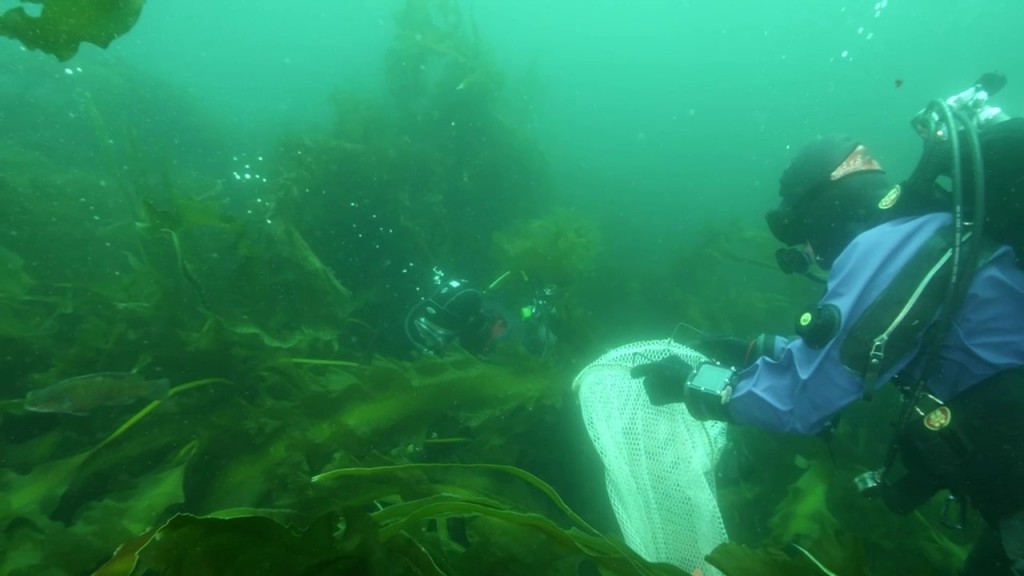Frank Carini: The uncertain future of 'the Yellowstone of the North Atlantic'
Kelp forest on Cashes Ledge
— Conservation Law Foundation photo
From ecoRI News (ecori.org)
Robert Lamb, as a Ph.D. student at Brown University, saw firsthand the “incredible diversity, breathtaking plant life, and healthy fish populations” that call Cashes Ledge home.
Lamb recently told ecoRI News that this pristine ecosystem is unlike anything else in the Gulf of Maine. That’s why he was part of a team that worked to permanently protect the 550-square-mile area that is 80 miles off the coast of Gloucester, Mass.
Led by Brown University Prof. Jon Witman, a team of divers from the Providence university, the Woods Hole Oceanographic Institution, the University of New Hampshire, and the National Park Service worked with the Conservation Law Foundation to document the bounty of marine life that exists at Cashes Ledge — a 22-mile-long underwater mountain range with average depths of 90 to 130 feet — and assess its vulnerability. This 4-minute video highlights some of that work.
The team’s efforts of four years ago, including holding roundtables and giving talks across the region, were undertaken in hopes that Cashes Ledge would be awarded a monument designation. The effort failed, but it did play a part in the creation, three years ago, of the Northeast Canyons and Seamounts Marine National Monument, the only national monument in the Atlantic Ocean.
Lamb, who now works with the Witman Lab and the Woods Hole Oceanographic Institution on various marine issues, believes that Cashes Ledge deserves the same protection, especially since the Gulf of Maine is one of the fastest-warming bodies of salt water in the world. He said the destruction of such an important underwater habitat would be devastating.
During the many dives the researchers and scientists took, censuses they conducted, and comparisons they made between Cashes Ledge and exploited coastal areas, such as the Isles of Shoals and Star Island, they found that fish biomass was about 500 times greater there than anywhere in the near shore and kelp biomass was also significantly greater, according to Lamb.
He noted that Cashes Ledge’s dense kelp forest is the most productive one in the North Atlantic.
The peaks and canyons of Cashes Ledge create nutrient- and oxygen-rich currents that support diverse habitats. The area is home to Atlantic wolffish, cod, cusk, sea stars, sea squirts, sea pens, horse mussels, anemones, rare sponges, and the largest continuous kelp forest along the Atlantic Seaboard. It also acts as a migratory pass for blue and porbeagle sharks, humpback and right whales, and bluefin tuna.
The value of Cashes Ledge has been recognized by the New England Fishery Management Council, as it has designated a large swath of the area as “essential fish habitat” for American plaice, Atlantic cod, haddock, halibut, monkfish, pollock, white hake, and witch flounder. The area is currently restricted, meaning most forms of fishing are prohibited.
Those protections, however, are “too little,” according to Lamb.
“It’s one of those places that is so unique and so beautiful … a treasure,” he said. “It merits protection for that reason alone, if not for the fisheries benefits. If you have a place where fish are allowed to grow unchecked and unimpeded by fishing, that creates a surplus of individuals that will swim, or disperses larvae, to other places that then can he caught, so it indirectly benefits fisheries.”
The partially protected area is also home to Ammen Rock, a peak so tall that it disrupts the Gulf of Maine current and creates upwellings of cold, nutrient-rich water which sustains the ledge’s vast variety of life.
Noted marine biologist Sylvia Earle has called Cashes Ledge “the Yellowstone of the North Atlantic.”
Modern commercial fishing technologies, however, make Cashes Ledge susceptible to damage. A bottom trawl, for example, could strip clear the kelp forest on Ammen Rock and completely alter the ecosystem, according to the Conservation Law Foundation. The Boston-based environmental advocacy organization has noted that some anemone populations could take up to 230 years to recover from a single drag of a bottom trawl.
Protected areas also have been shown to be more resilient to climate change, and provide sea life places to adapt to warming and acidifying waters.
See this video about Cashes Ledge.
Frank Carini is editor of ecoRI News.
